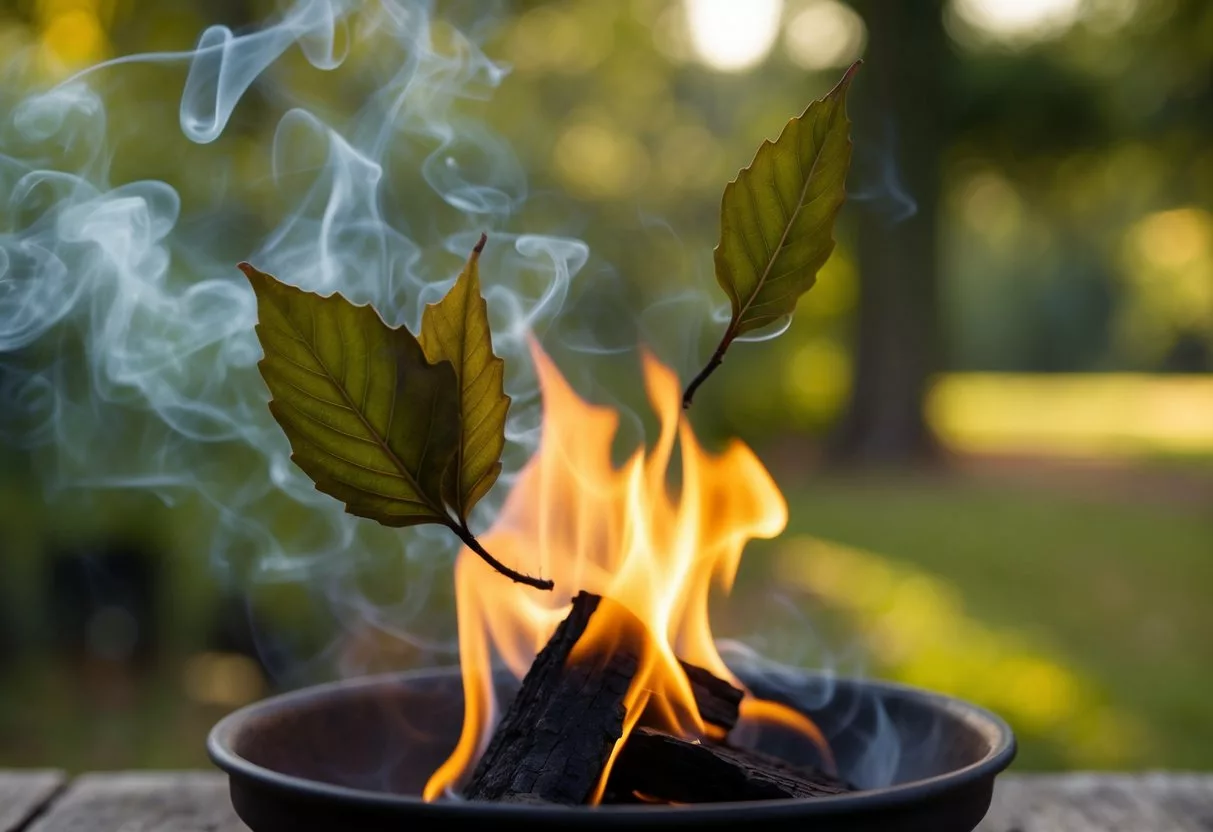Burning bay leaves is an ancient practice with roots in many cultures. People have used this method for centuries, believing it brings various benefits. When you burn bay leaves, the smoke may help reduce stress, improve breathing, and keep insects away.

Bay leaf burning has gained popularity as a natural remedy. Some claim it can ease anxiety and promote relaxation. Others use it to clear the air and create a pleasant scent in their homes. While scientific proof is limited, many people find the practice helpful.
It’s important to be careful when burning bay leaves. Always do it in a well-ventilated area and keep an eye on the flame. Some people may be sensitive to the smoke, so it’s best to start with small amounts and see how you react.
Key Takeaways
- Bay leaf burning may help reduce stress and improve air quality
- The practice has historical roots and is used in various cultures
- Safety precautions are important when burning bay leaves at home
Historical and Cultural Significance

Bay leaves have played an important role in many societies for thousands of years. People have used them in religious ceremonies, medicine, and cooking across different cultures.
Ancient Traditions and Mythology
In ancient Greece, bay leaves came from the laurel tree. This tree was sacred to Apollo, the god of light and poetry. People made wreaths from bay leaves to crown winners of games and honor poets.
The Romans also valued bay leaves highly. They saw them as symbols of wisdom and victory. Roman emperors and warriors wore bay leaf crowns to show their power and ward off evil spirits.
In some cultures, people burned bay leaves in temples and homes. They thought the smoke could cleanse spaces and bring good luck.
Traditional Medicine across Cultures
Many cultures have used bay leaves for healing. In ancient times, people thought bay leaves could cure many illnesses.
They used bay leaves to:
- Reduce pain
- Help with digestion
- Treat respiratory problems
- Lower fevers
Some traditional healers made teas from bay leaves. Others used bay leaf essential oil for massages and aromatherapy.
Even today, some people burn bay leaves to reduce stress and clear their minds. The smell is thought to have a calming effect.
Bay Leaves in Culinary Uses
Bay leaves have been used in cooking for centuries. Their distinct flavor enhances many dishes.
Common culinary uses include:
- Adding flavor to soups and stews
- Seasoning meat dishes
- Flavoring rice and pasta sauces
Cooks usually remove whole bay leaves before serving. The leaves can be tough to eat.
In some places, people grind dried bay leaves into a powder. This powder can be used as a spice in various recipes.
Bay leaves are a key ingredient in many traditional spice blends. They add depth and complexity to the flavor of foods.
Health and Medicinal Benefits

Burning bay leaves offers several potential health benefits. These range from reducing stress to aiding digestion and supporting respiratory health.
Reducing Anxiety and Stress
Burning bay leaves may help reduce anxiety and stress. The smoke contains linalool, a compound with calming properties. When inhaled, this smoke might ease tension and promote relaxation.
To use bay leaves for stress relief:
- Place 1-2 dried bay leaves in a heat-safe dish
- Light the leaves and let them smoke
- Inhale the smoke for 10-15 minutes
Some people find this practice helpful during meditation. It may improve focus and create a calming atmosphere.
Aromatherapy and Respiratory Health
Bay leaf smoke might benefit respiratory health. The leaves contain eucalyptol, which could help with breathing issues.
Potential benefits for the respiratory system:
- Easing congestion
- Reducing mucus
- Soothing irritated airways
People with asthma or allergies should be careful. The smoke might trigger symptoms in some cases. It’s best to consult a doctor before trying this for respiratory issues.
Anti-Inflammatory and Antioxidant Effects
Bay leaves have anti-inflammatory and antioxidant properties. When burned, these compounds are released into the air. Inhaling the smoke might provide some benefits.
Potential effects:
- Reducing inflammation in the body
- Supporting the immune system
- Fighting free radicals
The compound eugenol in bay leaves may contribute to these effects. More research is needed to fully understand how inhaling bay leaf smoke impacts inflammation and oxidative stress.
Managing Blood Sugar and Digestion
Some studies suggest bay leaves might help manage blood sugar levels. This could be beneficial for people with type 2 diabetes. However, most research has focused on consuming bay leaves, not burning them.
Bay leaves may also aid digestion. The smoke might:
- Stimulate digestive enzymes
- Reduce indigestion
- Ease stomach discomfort
While burning bay leaves for these purposes is less common, some people find it helpful. As with any health practice, it’s important to consult a healthcare provider before using bay leaf smoke for medicinal purposes.
Practical and Safety Considerations

Burning bay leaves can be beneficial, but it’s important to do it safely. Proper methods, awareness of risks, and good ventilation are key for a positive experience.
Proper Methods for Burning Bay Leaves
To burn bay leaves safely, use a fireproof bowl like a ceramic dish. Place one or two dried bay leaves in the bowl. Light the leaves with a match and let them smolder. The leaves will release aromatic smoke as they burn.
Don’t use fresh leaves, as they won’t burn well. Let the leaves burn completely to ash. This process usually takes 5-10 minutes.
Always supervise the burning process. Never leave burning leaves unattended. Keep water nearby in case you need to extinguish the flame quickly.
Potential Risks and Allergens
While generally safe, burning bay leaves can pose some risks. Some people may be allergic to bay leaf smoke. Symptoms can include sneezing, coughing, or skin irritation.
The smoke contains compounds that may irritate eyes or lungs. People with asthma or other respiratory issues should be extra careful.
Keep children and pets away from burning bay leaves. The leaves and ashes can be harmful if ingested. The hot ceramic dish can also cause burns if touched.
Ventilation and Air Quality
Good ventilation is crucial when burning bay leaves. Open a window to let fresh air in and smoke out. This helps maintain good air quality and reduces the risk of smoke inhalation.
If the room gets too smoky, stop burning the leaves and air out the space. Don’t burn bay leaves in small, enclosed areas without proper air flow.
Some claim burning bay leaves can improve respiratory health, but there’s limited scientific evidence for this. It’s best to err on the side of caution and avoid excessive smoke exposure.
After burning, let the ashes cool completely before disposal. Dispose of them safely, away from flammable materials.
Psychological and Emotional Effects

Burning bay leaves may impact mental states and emotions. The practice is linked to several potential benefits for the mind.
Enhancing Concentration and Mindfulness
Burning bay leaves might boost focus and mindfulness. The scent can increase alertness and help clear the mind. Some people use it during meditation or work to stay on task.
The aroma may sharpen concentration. This could be helpful for students or professionals who need to focus for long periods.
Bay leaf smoke contains linalool. This compound may improve cognitive function. It could make it easier to pay attention and process information.
Influence on Mood and Well-Being
The aroma of burning bay leaves may reduce stress and anxiety. Many find the scent soothing. It might create a sense of calm and peace.
Some report feeling more positive after burning bay leaves. The practice could lift spirits and ease mild feelings of sadness.
The ritual of burning leaves may itself be relaxing. Taking time for this activity can be a form of self-care. It may help people feel more balanced and centered.
While more research is needed, many find bay leaf burning helpful for emotional well-being. It’s seen as a natural way to boost mood and reduce stress.
Additional Uses and Benefits

Bay leaves offer more than just culinary uses. They can help repel pests and aid in healing various ailments.
Bay Leaves as a Natural Insect Repellent
Bay leaves work well as a natural insect repellent. Their strong aroma keeps bugs away. People often place dried bay leaves in pantries to ward off moths and other pests. The leaves also deter mice.
To use bay leaves as a repellent:
- Scatter whole leaves in cabinets and drawers
- Make sachets with crushed leaves
- Burn a leaf to release the scent
The smell of bay leaves is pleasant to humans but off-putting to insects. This makes them a safe, non-toxic option for pest control in homes.
Bay Leaf’s Role in Healing and Recovery
Bay leaves have medicinal properties that may help with healing. They contain compounds like pinene and cineol. These substances have anti-inflammatory effects.
Bay leaf tea can ease digestive issues. It may also help clear phlegm from the respiratory system. Some people apply cooled bay leaf tea to wounds to speed healing.
For joint pain, try this method:
- Boil bay leaves in water
- Let the mixture cool slightly
- Soak a cloth in the liquid
- Apply the cloth to sore joints
While more research is needed, many people find relief using bay leaves for various health issues.
Frequently Asked Questions

Burning bay leaves raises questions about safety, benefits, and proper techniques. People want to know how it affects humans, pets, and insects, as well as what substances are released during burning.
Are there any health risks for humans associated with burning bay leaves?
Burning bay leaves is generally safe for humans. The smoke can irritate eyes or lungs if inhaled directly. People with asthma or breathing issues should be careful.
Always burn bay leaves in a well-ventilated area. Don’t inhale the smoke directly. Stop if you feel any discomfort.
Can burning bay leaves cause harm to pets, such as dogs?
Pets can be more sensitive to smoke than humans. The smell might bother dogs and cats. Keep pets away from burning bay leaves.
If a pet inhales too much smoke, it could cause breathing problems. Watch for coughing or difficulty breathing in pets after burning bay leaves.
What are the potential benefits of conducting a bay leaf burning ritual in your home?
Bay leaf burning may help reduce stress and anxiety. The scent can be calming. Some people use it to improve focus and clarity.
Bay leaves contain a chemical called linalool. This might help promote relaxation when burned. More research is needed to confirm these effects.
How should one properly burn bay leaves to potentially reduce anxiety?
Use a heat-safe dish or bowl. Place a dry bay leaf inside. Light the leaf with a match or lighter. Let it burn for a few minutes.
Stay in the room and breathe normally. Don’t inhale the smoke directly. Put out the flame if it gets too big. Open windows for ventilation.
What substances are released into the air when a bay leaf is burned?
Bay leaves release essential oils when burned. These include eucalyptol, myrcene, and linalool. The smoke also contains small particles.
These substances create the distinct smell of burning bay leaves. Some may have calming effects, but more studies are needed to confirm this.
Is there evidence that burning bay leaves can help repel insects such as mosquitoes?
There’s limited evidence that burning bay leaves repels insects. Some people use it for this purpose, but its effectiveness is not well-studied.
Other methods, like citronella candles or bug spray, have more proof behind them for mosquito control. Bay leaf smoke might provide some insect-repelling effects, but don’t rely on it alone.